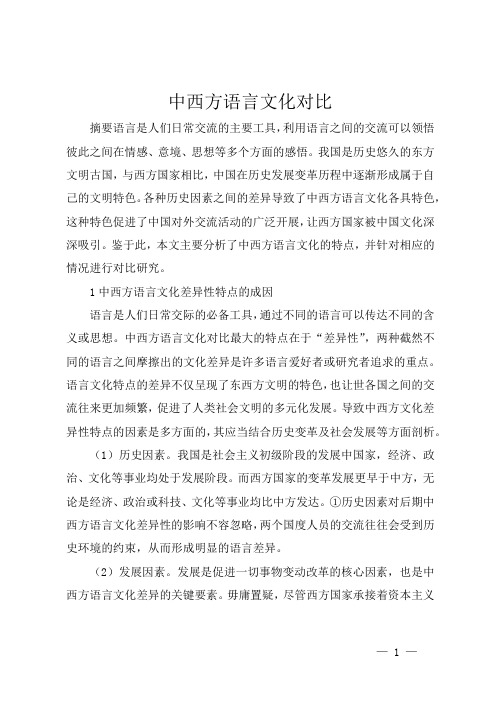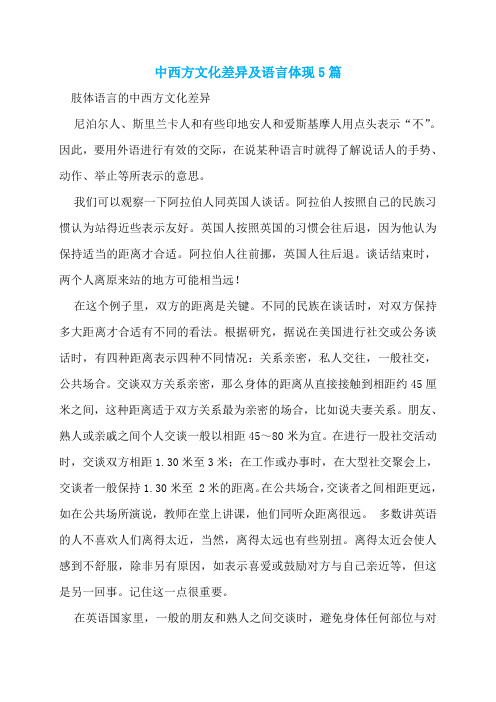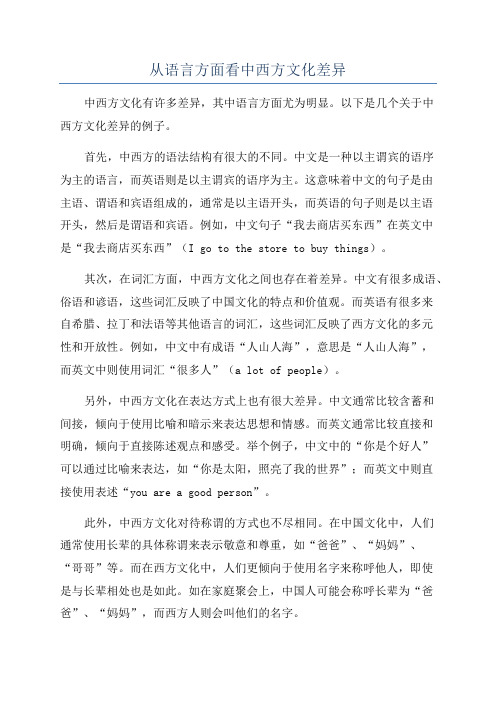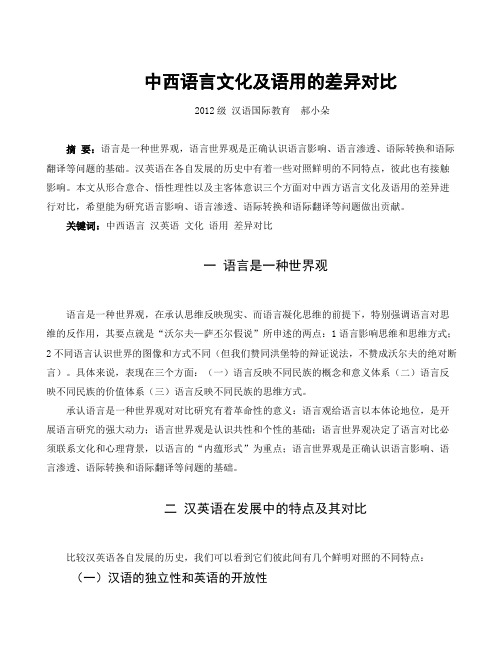中西语言文化对比
中西语言文化比较

中西语言文化比较第一 委婉语的比较中西委婉语差异的原因:英语和汉语的委婉语虽然有很多相同或相似之处,但它们毕竟是两种不同的语言。
(汉藏语系和印欧语系)由于英汉两种语言本身的差异,以及不同的自然地理环境、历史背景和宗教信仰的差异所形成的不同价值观念、风俗习惯、思维方式和伦理道德观念,因而使委婉语蕴含了迥然不同的民族特征。
(东方文化和西方文化) 一、谦让与回避在中国,以谦敬的方式表达委婉和礼貌由来已久,因为中国人自古讲究谦恭礼让,谦虚是一种传统的美德,俗语就有―人敬我一尺,我敬人一丈‖,所谓―文质彬彬,然后君子‖。
用于己方的称呼或相关事物、行为多用自谦的方式,尽量往卑贱处说,而用于对方的则采取敬重的方式,尽量往高贵处说。
在中国人看来,言谈之中表现出的这种谦虚或恭敬,会给交谈对方一种尊重感,从而乐于倾听和接受,收到良好的交际效果,同时也表现出讲话者的文化涵养。
1、礼物和赞美的谦让● 称自己的礼物做―小意思‖、―表示表示‖;● 称自己水平不高会说:―我那几下子,你还不知道?‖;● 称自己的腹围大时用―啤酒肚‖,称别人则用―将军肚‖;● 作家们把自己的职业说成―爬格子‖、―码字‖,以示平民意识。
(自谦自抑——尊重)听到赞美之词,汉语中多回答:―区区小事,何足挂齿?‖―过奖了!‖―请多包涵。
‖诸如此类的客套话,而英语中则表现为欣然接受,答之以:―Thank you .‖(谢谢)―I will be glad to…‖(我很高兴……)―I‗m glad you like it.‖(你喜欢我很高兴。
)―That‘s very kind of you to say so.(你这样说太好了。
)等等。
(含蓄与直率)2、隐私和死亡●关于上厕所,英语有wash one‘s hand, relieve oneself, powder her nose;汉语有洗手、解手,去化妆间。
●关于残疾,如对身体有缺陷的人,英语称呼disabled person,汉语用―残疾人‖而不说―残废人‖。
中西语言文化对比

show difficulty in distinguishing between imaginary and factual material/with credibility gap
need help in learning to adhere to rules standards of fair play
1.官方委婉语
•美国政府机构汇集了各种官方英语(officialese),文 武官员职员分别盛行联邦政府官僚英语 (bureaucratese)、五角大楼英语(Pentagonese)、 国务院英语(State-Departmentese)、官腔英语 (gobbledygook)以及各地方市政府英语 (urbababble)。
e.g. To my no small astonishment, I found the house on fire.
Her face wasn’t a bad one; it had what they called charm. 英语常用一些否定的形式拐弯抹角的表达强烈的肯定 意义
e.g. I couldn’t feel better. One could not be too careful in a new
这类动词的名词化结构往往也能转移否定 It is not our opinion that your supposed contract is practical.
(2)用肯定的形式来表达否定的意义,这类表达法常 见于含蓄虚拟句、反意问句、省略句、诅咒句和讽刺 语。
2.职业委婉语(occupational euphemism)
在当代英美社会里,人们为了装饰门面,提高 某些行业的社会地位,满足自尊心和虚荣心, 常常创造一些悦耳动听、冠冕堂皇的委婉语 (uplifting word or impressive title)来称呼某些职 称或职业。 meat technologist (=butcher)屠夫 prison officer (=gaoler)监狱看守 research consultant (=file clerk)档案管理员 law enforcement officer(=cop)警察 ......
中西语言文字对比_辜正坤_北大博导

中西语言文字与文化比较演讲人简介:辜正坤,博士生导师,中国莎士比亚研究会副会长,曾发表理论专著及英汉译本《老子道德经》、《毛泽东诗词》、《未来之路》等35种著作和论文100多篇。
我主要讲述语言文字之间的不同如何造成文化之间的不同,以及语言文字的诱导和暗示作用,并重点分析中国文化和外国文化的差别。
首先我想给文化下一个定义。
第一,我所说的文化是广义上的文化,是包括人、环境、知识、技术成果等一切别具特色的物质对象。
第二,文化由方方面面的因素决定,我个人认为,文化由九大因素决定,即环境、语言文字、科技、物欲原动力、情欲原动力、权欲原动力、审美、阴阳、万物选择。
语言文字只是其中之一。
那么语言文字又是怎样作为一种纵向的诱导或者暗示因素对文化产生作用,并且在很多场所表现为制约性因素的呢?要回答这个问题首先面临一个对语言学权威观点的挑战。
西方语言学界主流的观点认为,语言(包括文字)的形成是任意的,必然的因素很少,把人叫做人,把天叫做天,把男人叫做男人,把女人叫做女人,这些都是随心所欲的称呼,没有必然性。
几乎所有教课书都把“人具有任意性”作为一个公理来看待,西方语言学界也认为这是语言学的基础。
而我个人的看法正好与此相反,我认为语言文字的产生昭示了一个规律性,即语言是在特定场合、特定时间、特定因素的较深作用下必然要产生的。
当然其中也有任意因素,任意是相对的,非任意也是相对的,但是哪一个是主要的,这其中有一个关系:早期往往是必然性因素占主要,慢慢随着人的主观能动性和主体意识的增强,任意性因素才慢慢增强。
越是远古,人类越不可能任意地创造一种文字或者语言,只能是“近取诸身,远取诸物”,不能像现代人一样进行抽象思维。
远古人类的创造能力很简单,比如象形字产生于图画文字,而全世界的语言文字如果向前追溯,就会发现它们都产生于图画文字。
文字发展的过程,体现了人类智力发展运行的轨迹慢慢地从具体走向抽象。
而西方语言文字的很多东西都是从其他文化借鉴过来的,并不是直接发展出来的。
中西文化差异具体举例

中西文化差异具体举例一、交际语言的差异日常打招呼,中国人大多使用“吃了吗?”“上哪呢?”等等,这体现了人与人之间的一种亲切感。
可对西方人来说,这种打招呼的方式会令对方感到突然、尴尬,甚至不快,因为西方人会把这种问话理解成为一种“盘问”,感到对方在询问他们的私生活。
在西方,日常打招呼他们只说一声“Hello”或按时间来分,说声“早上好!”“下午好!”“晚上好!”就可以了。
而英国人见面会说:“今天天气不错啊!”称谓方面,在汉语里,一般只有彼此熟悉亲密的人之间才可以“直呼其名”。
但在西方,“直呼其名”比在汉语里的范围要广得多。
在西方,常用“先生”和“夫人”来称呼不知其名的陌生人,对十几或二十几岁的女子可称呼“小姐”,结婚了的女性可称“女士”或“夫人”等。
在家庭成员之间,不分长幼尊卑,一般可互称姓名或昵称。
在家里,可以直接叫爸爸、妈妈的名字。
对所有的男性长辈都可以称“叔叔”,对所有的女性长辈都可以称“阿姨”。
这在我们中国是不行的,必须要分清楚辈分、老幼等关系,否则就会被认为不懂礼貌。
中西语言中有多种不同的告别语。
如在和病人告别时,中国人常说“多喝点开水”、“多穿点衣服”、“早点休息”之类的话,表示对病人的关怀。
但西方人绝不会说“多喝水”之类的话,因为这样说会被认为有指手画脚之嫌。
比如他们会说“多保重”或“希望你早日康复”等等。
二、餐饮礼仪的差异中国人有句话叫“民以食为天”,由此可见饮食在中国人心目中的地位,因此中国人将吃饭看作头等大事。
中国菜注重菜肴色、香、味、形、意俱全,甚至于超过了对营养的注重,只要好吃又要好看,营养反而显得不重要了。
西方的饮食比较讲究营养的搭配和吸收,是一种科学的饮食观念。
西方人多注重食物的营养而忽略了食物的色、香、味、形、意如何,他们的饮食多是为了生存和健康,似乎不讲究味的享受。
在餐饮氛围方面,中国人在吃饭的时候都喜欢热闹,很多人围在一起吃吃喝喝,说说笑笑,大家在一起营造一种热闹温暖的用餐氛围。
中西方语言文化对比

中西方语言文化对比摘要语言是人们日常交流的主要工具,利用语言之间的交流可以领悟彼此之间在情感、意境、思想等多个方面的感悟。
我国是历史悠久的东方文明古国,与西方国家相比,中国在历史发展变革历程中逐渐形成属于自己的文明特色。
各种历史因素之间的差异导致了中西方语言文化各具特色,这种特色促进了中国对外交流活动的广泛开展,让西方国家被中国文化深深吸引。
鉴于此,本文主要分析了中西方语言文化的特点,并针对相应的情况进行对比研究。
1中西方语言文化差异性特点的成因语言是人们日常交际的必备工具,通过不同的语言可以传达不同的含义或思想。
中西方语言文化对比最大的特点在于“差异性”,两种截然不同的语言之间摩擦出的文化差异是许多语言爱好者或研究者追求的重点。
语言文化特点的差异不仅呈现了东西方文明的特色,也让世各国之间的交流往来更加频繁,促进了人类社会文明的多元化发展。
导致中西方文化差异性特点的因素是多方面的,其应当结合历史变革及社会发展等方面剖析。
(1)历史因素。
我国是社会主义初级阶段的发展中国家,经济、政治、文化等事业均处于发展阶段。
而西方国家的变革发展更早于中方,无论是经济、政治或科技、文化等事业均比中方发达。
①历史因素对后期中西方语言文化差异性的影响不容忽略,两个国度人员的交流往往会受到历史环境的约束,从而形成明显的语言差异。
(2)发展因素。
发展是促进一切事物变动改革的核心因素,也是中西方语言文化差异的关键要素。
毋庸置疑,尽管西方国家承接着资本主义发展模式,但其与中国的社会主义阶段更加先进。
西方国家在各个行业领域的发展水平均超出中国许多,国家发展因素引导了语言文化交流的方向,中西方发展水平的巨大反差造成了语言文化上的明显差异。
(3)文化因素。
面对强烈的国际竞争,中国正忙于经济、政治等事业发展,对于文化事业并没有给予足够的重视。
而西方国家在长期变革发展中已经形成相对完善的文化体系,不仅积极发展了本国的文化特色,对海外先进文化也积极吸收学习,更加巩固了西方文化的深厚基地。
中西方文化差异及语言体现

中西方文化差异及语言体现一、中西方文化间的差异1.风俗习惯的差异对女性的态度美国妇女和中国妇女的地位都不高,但美国妇女却有幸能享受许多优待,尊重妇女的礼节在美国社会随处可见:男士为女士开门;扶女士下车;在马路上,男士走女士外侧,以给女士提供保护。
对婚姻的态度西方人的婚姻观与中国人的婚姻观有着极大的不同。
在在他们看来:婚姻纯属个人私事,任何人不能干涉。
在他们看来:强迫两个不相爱的人生活在一起是残忍的。
中国人的婚姻相对来说比较谨慎。
因为中国人把婚姻当作人生的头等大事,一旦决定了,就不会轻易改变。
2.社会礼仪的差异中国人通常是见面点头致意,或微微欠身行握手、拱手礼,而西方人认为欠身显得自卑,拥抱是最常见的见面礼与道别礼,亲吻礼与吻手礼也较为常见。
对于别人的赞扬,中国人通常表示谦虚;而西方人总是高兴地回答“Thank you”以表接受。
中国人收到礼物时往往放在一边,等客人走了再打开。
3.社会关系的差异平等意识与等级观念西方人平等意识较强,无论贫富,人人都会尊重自己,不允许别人侵犯自己的权利。
同时,人人都能充分地尊重他人。
正如美国所信奉的箴言所说:“只要努力,牛仔也能当总统。
”家庭关系美国式的家庭结构比较简单,这种作法虽疏远了亲属之间的关系,但却给年青人提供最大限度的自由,有利于培养其独立生活的能力。
中国式的家庭结构比较复杂,多是几世同堂聚居。
在这样的家庭中,老人帮助照看小孩,儿孙们长大后帮助扶养老人,家庭成员之间互相依赖,互相帮助,密切了亲情关系,但不利于培养年青人的独立能力。
4.价值观与道德标准的差异个人荣誉感与谦虚谨慎西方人崇拜个人奋斗,尤其为个人取得的成就自豪,从来不掩饰自己的自信心、荣誉感以及在获得成就后的狂喜。
相反,中国文化不主张炫耀个人荣誉,而是提倡谦虚,但中国式的自我谦虚或自我否定却常常使西方人大为不满。
自我中心与无私奉献西方人自我中心意识和独立意识很强,每个人生存方式及生存质量都取决于自己的能力,因此,每个人都必须自我奋斗,把个人利益放在第一位。
中西方语言与文化差异

中西方语言与文化的差异中西方语言与文化的差异简介:中西方语言与文化的差异不少英语爱好者片面地认为.只要学好外浯埂可与外国入交流其实不然.如果不了解中阳文化的差异.对西方礼仪矢『]之甚少.那么在与外围入交流中会造成许多误会.本人就从包括“迎送...不少英语爱好者片面地认为.只要学好外浯埂可与外国入交流其实不然.如果不了解中阳文化的差异.对西方礼仪矢『]之甚少.那么在与外围入交流中会造成许多误会.本人就从包括“迎送、会谈、宴请、交际、接待”等几个方面略谈中两文化的差异、语言的交流。
一、称谓礼数。
称呼恰当,是尊重对方。
与外宾初次见面,最安全的称呼是男子称先生(Mr·),女子称夫人(Mm·),女士称(Ms·),小姐称(Miss)。
这些称呼均可冠于姓名、职称、衔称等前面。
如“怀特夫人(MrS White)”、“秘书小姐(Miss Secretary)”;而我们中国入出于对客人的尊重.不肯直呼客人的姓名或父母的姓名。
两方入则不同,除非在正规场合.在⋯般场合中.他们更愿意别人直呼其名。
例如:Lindalane Chapman.如果你称呼她Miss Chapman(Chapman 女士)或者Miss Linch (Linch小姐),她会感觉你与她不熟。
二、交往语言。
假如你是一家公司的翻译,陪同老板去机场迎接来自美国的生意人,你不能说:“你一路上辛苦了”.而J立该说:“Did you have agood night?”或“Did you have a good flight?”如果你说:“You must be very tired.或You must be exhaust—ed.”客人会觉得自己的身体很差,人家才这样说。
外国朋友到家中做客,中国人会说:“欢迎,欢迎”,客人会一笑。
点点头。
如果翻译成英语,就是“Wel—come!W elcome[”或“你来了?(You have come!)”这种英语在外国不常用。
中外文化之间的对比

中外文化之间的对比中外文化的对比一直是人们关注的焦点之一。
中文作为一种古老而复杂的语言,充满了许多独特的文化内涵。
与之相比,英语作为一种全球通行的语言,则更倾向于简约和实用。
本文将分别探讨中外文化方面的差异,希望读者能对中外文化有更深入的了解。
一、语言的对比中文与英语这两种语言在结构上有很大的差异。
中文的语法结构比英语更为复杂,而英语则更注重句子的简洁明了。
例如,中文中有很多发音相同的词语,但由于汉字的不同组合,这些词语又有着不同的含义。
相比之下,英语的发音则更加规范,但同音异义词也存在。
此外,中文中有很多成语、俗语和谚语,其中蕴含着丰富而深刻的文化内涵。
而英语中则更多地使用短语和俗语。
二、食物的对比中西方文化在饮食方面也有着较大的差异。
中国菜以其丰富的口味和独特的烹饪方法而著称,例如糖醋排骨、宫保鸡丁和麻辣火锅等。
中国菜注重食物的颜色、味道和质地的均衡,注重食物在口感和健康方面的平衡。
与之相比,西餐更注重菜肴的质地和营养成分。
其中的例子包括沙拉、烤牛排和焗蔬菜等。
西餐更容易吸收即可食用的食品。
三、文化的对比中西文化最重要的差异之一在于儒家思想和基督教文化的影响。
中国文化从儒家思想中吸取了许多价值观,例如尊重家长、敬老尊贤和对家庭和婚姻的重视。
这与基督教文化中的关注个体权利和自由有着很大的区别。
中西文化的另一个区别在于对时间的看法。
在中国文化中,时间是一种环流,注重过程和沉淀,而西方则更注重时间的线性和花絮,准时非常重要。
四、交际方式的对比在交际方面,中国人更注重面子和人际关系。
这种注重关系的现象在中国文化中有着深远的历史根源,而在西方文化中不太突出。
此外,中国人更害羞,更注重隐私,英国人则较为开放和直接。
在社交性质的场所(如酒店、社交活动等),中国人会更加谦虚、恭敬、礼貌。
然而,在英国社交场合中,人们更注重聊天,冗长的对话也是再正常不过的事。
感性的人更能理解不同文化之间的差异,因为文化与语言、食物、习惯、价值观、个人隐私等方面的联系非常密切。
第四章、中西语言文化比较

中西语言文化比较语言作为一个整体与文化发生关系,无论是文化对语言的影响,还是语言对文化的承载,两者之间的相互作用都是发生在语音词汇、语法文字等几个方面。
一、语音的比较世界诸语言从声调上可分为声调语言与非声调语言。
声调语言中的声调(表现在字调上),同辅音元音一样,起着辩义的功能。
如汉语普通话的“妈……”,发音相同,但因声调不同而意义有别。
而非声调语言,例如英语,其声调只担负语气的功能。
汉语有四声,而英语等印欧语系的口语中无四声。
这是汉英语在语音上的最重要的区别之一。
汉字基本上都是单音节,在1300多个单字音节中,除去四声音调特征之后,只有429个单音节,它们可以组成数十万条词组。
而英语单词多是多音节,英语中约有1200个音节,有重音但无四声。
汉语四声形成了发音的抑扬顿挫,产生一种唱歌的特征。
中国古诗读起来很有音乐美。
有的学者说汉语是一种诗歌的语言。
英语是以清重音区别词义的语言。
例如content 的重音放在第一音节时为名词,意为“内容”,放在第二音节时为动词,意思为“满足”。
在英语和汉语之间,诗是既可译的又是不可译的。
意象是可以译的,但有时需要转换,或加注释。
音律则是不可译的,无论是英译汉还是汉译英,由于语音的特征,汉语诗歌的格律为“平仄律”,英语诗歌的格律为“轻重律”。
汉语中存在大量的同音词汇,为中国文学和民间文艺的某些特色提供了沃土。
汉语中同音字、词很多,据对45300条汉语词目的统计,同音词占38.6%。
为利用谐音开了方便之门。
气管炎(妻管严),春节年画,年年有鱼(余),送“钟”作礼物,称“闹表”,“箸”称“筷子”。
上述文化特色在跨文化交流翻译成英语时,就会大打折扣。
二、词汇的比较不同民族在发展过程中,各自创造出了具有特色的物质文明与精神文明,反映在语言上,文化不仅影响了词汇的字面意义,也影响了词汇的引申意义。
1。
平行词汇指在两种语言中其字面意义不同,但引申意义相同的词汇。
为了表达同一意思,两种不同的语言有时使用字面意义不同的词,我们称为“平行词”他瘦得象猴子似的。
中西方文化差异及语言体现5篇

中西方文化差异及语言体现5篇肢体语言的中西方文化差异尼泊尔人、斯里兰卡人和有些印地安人和爱斯基摩人用点头表示“不”。
因此,要用外语进行有效的交际,在说某种语言时就得了解说话人的手势、动作、举止等所表示的意思。
我们可以观察一下阿拉伯人同英国人谈话。
阿拉伯人按照自己的民族习惯认为站得近些表示友好。
英国人按照英国的习惯会往后退,因为他认为保持适当的距离才合适。
阿拉伯人往前挪,英国人往后退。
谈话结束时,两个人离原来站的地方可能相当远!在这个例子里,双方的距离是关键。
不同的民族在谈话时,对双方保持多大距离才合适有不同的看法。
根据研究,据说在美国进行社交或公务谈话时,有四种距离表示四种不同情况:关系亲密,私人交往,一般社交,公共场合。
交谈双方关系亲密,那么身体的距离从直接接触到相距约45厘米之间,这种距离适于双方关系最为亲密的场合,比如说夫妻关系。
朋友、熟人或亲戚之间个人交谈一般以相距45~80米为宜。
在进行一股社交活动时,交谈双方相距1.30米至3米;在工作或办事时,在大型社交聚会上,交谈者一般保持1.30米至 2米的距离。
在公共场合,交谈者之间相距更远,如在公共场所演说,教师在堂上讲课,他们同听众距离很远。
多数讲英语的人不喜欢人们离得太近,当然,离得太远也有些别扭。
离得太近会使人感到不舒服,除非另有原因,如表示喜爱或鼓励对方与自己亲近等,但这是另一回事。
记住这一点很重要。
在英语国家里,一般的朋友和熟人之间交谈时,避免身体任何部位与对方接触。
即使仅仅触摸一下也可能引起不良的反应。
如果一方无意触摸对方一下,他(她)一般会说 Sorry;Oh,I’m sorry; E_cuse me等表示“对不起”的道歉话。
在中国,常常听到西方妇女抱怨中国人抚弄了她们的婴儿和很小的孩子。
不论是摸摸、拍拍、接接或是亲亲孩子,都使那些西方的母亲感到别扭。
她们知道这种动作毫无恶意,只是表示亲近和爱抚而已,所以也不好公开表示不满。
但在她们自己的文化中,这种动作会被人认为是无礼的,也会引起对方强烈的反感和厌恶。
中西语言文化比较..

主要思想: 1.语言和言语 2 .能指和所指 3 .共时态和历时态 4 .组合(句段)关系和联想 (聚合)关系
索绪尔认为存在两种不同的语言类型:一种是最少组织 性的;一种是最少任意性的。前者倾向于采用词汇的工 具,后者倾向于采用语法的工具。 索绪尔在举证时,以汉语与印欧语为例,指出汉语是“ 超等词汇的典型”,而印欧语是“超等语法的标本”。
例如: 有个农村叫张家庄。张家庄有个张木匠。张木匠有个好 老婆,外号叫个“小飞蛾”。小飞蛾生了个女儿叫“艾艾” ,算到一九五零年阴历正月十五元宵节,虚岁二十,周岁十 九。 (赵树理《登记》) 这段语句很难用我们现有的句子名称去指称它,显然它是汉 语独特的意合法的句式。
3. 宽式语言与严式语言
内容提要: 一、语言、思维与文化 二、羚羊挂角与板上钉钉 三、中国套盒与西洋项链 四、雾里看花与光风霁月
汉藏语系与印欧语系比较:羚源自挂角与板上钉钉1、语义语言与语法语言 2、意合语言与形合语言. 3、宽式语言与严式语言
中国套盒与西洋项链
1、立体与线性 2、散点与焦点 3、对偶与主从 4、真实与虚拟
第四章 神秘的魔圈
——中西语言文化比较
著名语言学家赵元任曾讲过一个故事,说从前有个老太太 头一次听外国话,觉得外国话怪得毫无道理,她说:“这 明明是水,可英国人偏偏儿要叫他‘窝头’(water), 法国人偏偏儿要叫它‘滴漏’(de l’eau),只有咱们中 国人好好儿的管它叫‘水’!咱们不但是管它叫水诶,这 东西明明儿是水嘿!”赵元任用这个故事说明语言有个特 征,即语言跟语言所表达的事物的关系完全是任意的,没 有任何必然的关系。 语言符号完全是约定俗成,其意义完全决定于各自所属的 符号系统。
三、高加索语系 1 南高加索语族 2 北高加索语族 四、乌拉尔语系 1 芬兰-乌戈尔语族 2 萨莫耶德语族 五、阿尔泰语系 1 突厥语族 2 蒙古语族 3 满-通古斯语族 六、达罗毗荼语系 1 北部语族 2 中部语族 3 南部语族
有关中西语言文化的差异

有关中西语言文化的差异中西语言文化的差异是由于两个完全不同的文化交流所带来的现象。
虽然中西方文化之间的交流已经有数百年的历史,但在语言和文化方面的差异还是依然存在。
对于中西方人来说,在探究另一种文化时,理解其语言和文化的不同是必不可少的。
这篇文章将发掘中西方语言文化的差异,并提供一些有帮助的解决办法。
一、语音与语调中西方语言的语音和语调是最突出的差异之一。
汉语是一种重音语言,即一个单词中只有一个音节被重读。
英语则是一种弱重音语言,如果一词有两个重音音节,那么它通常是重读第一个音节。
不同的语音特点意味着说话时的语调和语气会截然不同。
比如,在英语中,一小段话的最后一个词往往有较高的声音,而在华语中,常常在句末加上一个轻松的韵律。
二、非动词动词化在中西方语言文化的语法上,也存在重要的差异。
汉语中,动词可以用作名词,而且往往出现在句子的中心位置。
与此不同的是,在欧洲的大部分语言中,名词与动词的使用方式是完全不同的。
考虑到这个问题,西方人的思维习惯和语言习惯是不同的,因此在合作和沟通时,需要耐心地理解和学习彼此的语言文化差异。
三、礼貌用语在不同的文化中,礼貌用语也有差异。
在华语中,通常使用“您”作为尊称,而在英语中,并不像中文那么明确地表达尊敬,除了“sir”或“madam”这些明确表示的称呼外,许多词汇都是很普通的用语。
此外,在西方,使用幽默和讽刺的废话也被广泛使用,而这在中文社会则被视为不礼貌的行为。
因此,在不同的语言文化中,要小心使用和理解语言的表述方式,以免造成冒犯。
解决办法:1. 接受文化差异。
了解中西方文化和语言的差异是理解另一种文化的关键。
如果有理解不了的事情,不妨多了解一下对方的文化。
2. 多进行交流。
通过交流,可以消除跨文化之间的误解,合作更加愉快和有效。
了解对方的语言和文化,也要积极交流自己的语言和文化。
3. 学习语言。
如果有机会学习对方的语言,将有助于理解对方的文化和语言。
总之,中西方语言文化的差异是不可避免的,并且意味着合作和沟通时需要更加仔细地理解和学习彼此的语言文化差异。
从语言学角度对比中英语言文化差异

从语言学角度对比中英语言文化差异1. 引言1.1 背景介绍中英语言文化差异是一个复杂而广泛的话题,涉及到语音、词汇、语法、文化和交际方式等多个方面。
随着全球化进程的加速发展,不同语言文化之间的交流日益频繁,因此了解和研究中英语言文化差异显得尤为重要。
中英两国语言文化源远流长,各自拥有独特的语音体系、词汇特点、语法结构以及文化传统。
通过比较中英语言文化之间的差异,不仅可以帮助我们更深入地了解两国文化背景和社会习俗,还可以提升我们的跨文化交际能力,促进跨文化交流和理解。
本文将从语音、词汇、语法、文化和交际方式等多个角度出发,对中英语言文化差异进行深入探讨。
通过对比分析,我们可以更全面地认识中英两国语言文化之间的异同,从而促进跨文化交流,增进不同国家之间的相互理解和友谊。
【背景介绍结束】1.2 研究目的本研究的目的是通过从语言学角度对比中英语言文化差异,探讨两种文化背景下语言使用的异同之处。
具体来说,我们将比较中英语言的语音、词汇、语法、文化和交际方式等方面的差异,逐步揭示不同语言背景下的思维方式和沟通方式带来的文化差异。
通过深入研究中英语言文化差异,我们旨在促进跨文化交流和理解,为语言教学和跨文化交流提供参考。
通过对比研究中西语言文化的差异,也可以帮助我们更加深入地理解中英两种语言的内在逻辑和价值观念,为中英语言教育的发展提供借鉴和启示。
在全球化的背景下,中英两种语言文化的交流与融合日益频繁,因此对中英语言文化差异的研究不仅有助于增进彼此之间的理解和尊重,也能够为国际交流和合作提供更好的基础。
希望通过本研究,可以为加深人们对中英语言文化差异的认识,促进不同文化之间的交流和融合做出贡献。
1.3 意义意义语言文化差异是世界各国人们在沟通交流中面临的重要问题,其中中英语言文化差异作为两种重要的全球语言,具有显著的特点。
从语言学的角度对比中英语言文化差异,有助于更好地理解两种语言的特点和差异,促进跨文化交流和交流。
从语言方面看中西方文化差异

从语言方面看中西方文化差异中西方文化有许多差异,其中语言方面尤为明显。
以下是几个关于中西方文化差异的例子。
首先,中西方的语法结构有很大的不同。
中文是一种以主谓宾的语序为主的语言,而英语则是以主谓宾的语序为主。
这意味着中文的句子是由主语、谓语和宾语组成的,通常是以主语开头,而英语的句子则是以主语开头,然后是谓语和宾语。
例如,中文句子“我去商店买东西”在英文中是“我去商店买东西”(I go to the store to buy things)。
其次,在词汇方面,中西方文化之间也存在着差异。
中文有很多成语、俗语和谚语,这些词汇反映了中国文化的特点和价值观。
而英语有很多来自希腊、拉丁和法语等其他语言的词汇,这些词汇反映了西方文化的多元性和开放性。
例如,中文中有成语“人山人海”,意思是“人山人海”,而英文中则使用词汇“很多人”(a lot of people)。
另外,中西方文化在表达方式上也有很大差异。
中文通常比较含蓄和间接,倾向于使用比喻和暗示来表达思想和情感。
而英文通常比较直接和明确,倾向于直接陈述观点和感受。
举个例子,中文中的“你是个好人”可以通过比喻来表达,如“你是太阳,照亮了我的世界”;而英文中则直接使用表述“you are a good person”。
此外,中西方文化对待称谓的方式也不尽相同。
在中国文化中,人们通常使用长辈的具体称谓来表示敬意和尊重,如“爸爸”、“妈妈”、“哥哥”等。
而在西方文化中,人们更倾向于使用名字来称呼他人,即使是与长辈相处也是如此。
如在家庭聚会上,中国人可能会称呼长辈为“爸爸”、“妈妈”,而西方人则会叫他们的名字。
最后,中西方文化在交流方式和礼仪方面也有很多不同。
在中国文化中,人们尊重的是谦恭和谦虚。
平时交流时,中国人通常会使用一些客套话,如“请多关照”、“请多指教”等,以示尊重。
而在西方文化中,重视的是直接和坦率的交流方式。
人们通常会直接表达自己的观点和意见,而不太使用客套话。
浅论中西方语言文化差异

浅论中西方语言文化差异中西方语言文化差异是因为两种语言和文化的发展背景、历史和社会环境的不同而产生的。
在本文中,我们将从语言结构、沟通方式、价值观和礼仪等方面探讨中西方语言文化差异。
一、语言结构方面的差异1.词法结构:西方语言通常采用屈折语言,即词的形态会发生变化,如英语的复数形式;而中文属于属于瑞雪语,词形多不变化。
2.语法结构:中文语法注重修饰关系和成分顺序,英文则注重时态、语态和主谓宾等语法结构的表达。
二、沟通方式方面的差异1.隐晦与直接:中文通常表达时较为委婉和间接,而英文则更注重直接和明确的表达,这体现了不同文化背景下的沟通方式。
2.礼貌称呼:中文文化注重尊重和礼貌,因此在称呼上使用较多的尊称,如“先生”、“女士”,而英语文化在社交场合使用较少的尊称。
三、价值观方面的差异1.个人主义与集体主义:西方文化倾向于个人主义,强调个人的独立性和自由。
而亚洲文化则倾向于集体主义,强调团队、亲属和社会的利益。
2.时间观念:西方文化注重时间效率和准时性,而东方文化则较为灵活和注重人际关系。
四、礼仪方面的差异1.礼节:中文礼仪注重面子和尊重,需要注意如何适当地表现尊敬和婉拒;而西方礼仪注重个人空间和自我表达,强调独立和直接的交流。
2.身体语言:中文文化注重非语言交流,如点头、微笑等;而西方文化注重语言交流,身体语言较少使用。
综上所述,中西方语言文化差异体现在语言结构、沟通方式、价值观和礼仪等多个方面。
这些差异源于两种语言和文化的不同发展历程、社会环境和价值观念,对于理解和交流不同文化之间的人来说是非常重要的。
了解和尊重对方的语言和文化差异,有助于建立良好的跨文化交流和理解。
中西英语文化对比

英汉语言与文化对比语言是人类社会重要的交流工具,是反映人类社会生活的镜子。
语言是文化的重要载体,而文化则是主宰语言的灵魂,二者互相依赖、互相影响。
语言与文化是部分与整体的关系,即语言是文化的一部分,它具备文化的所有属性,因此,语言本身也是一种文化,并且是最重要的一部分文化。
语言通过自身的表达、交流和记载的功效将不同时期、不同地域的文化反映出来,承担着保留、扩展和传播文化的使命,所以语言是文化的载体,是发展文化的基础,与文化密不可分。
不懂得语言背后的文化准则,就不可能真正学好这门语言。
在英语教学中,英语教师若想真正帮助学生学好英语,就必须在教学过程中进行有效的文化导入,努力帮助学生掌握英语的文化背景知识,帮助学生充分理解和掌握语言信息背后的文化意义,最大限度地降低在听说读写译过程中出现文化障碍的可能性。
一、英汉语言文化差异文化包含一个民族创造出的所有精神产品和物质产品,能够体现出该民族在精神生活和物质生活方面的全部特性,包括该民族的语言特点、风俗习惯、民族性格等等。
中西方在思维方式、历史进程、宗教信仰等方面的差异造就了中西方两种截然不同的文化,其差异性体现在诸多方面,本文主要从以下五个方面探讨英汉语言文化的不同之处。
1.问候熟人或朋友相遇的时候彼此问候是最寻常不过的事情了,而中英两种文化在问候的方式上却存在很大差异。
中国人素来秉持着“民以食为天”的古训,长久以来在饭时前后人们常用的问候方式便是询问对方“你吃了吗?”这种问候方式并不意味着真正关心对方是否已经用餐,只是和英语中的“Hi”,“Hello”一样,一种再普通不过的问候方式。
而英语国家的人在表达问候时的常用话题是天气状况,如“It’s sunny,isn't it?”,有时也会谈论服饰、赛事、运动等等。
所以在进行跨文化交流时,要注意问候方式的差异,如若按照汉语问候方式将“你吃了吗?”译成英语向西方人表达问候,会令对方感很诧异,误把这句话当作用餐的邀请词。
中西语言文化及语用的差异对比

中西语言文化及语用的差异对比2012级汉语国际教育郝小朵摘要:语言是一种世界观,语言世界观是正确认识语言影响、语言渗透、语际转换和语际翻译等问题的基础。
汉英语在各自发展的历史中有着一些对照鲜明的不同特点,彼此也有接触影响。
本文从形合意合、悟性理性以及主客体意识三个方面对中西方语言文化及语用的差异进行对比,希望能为研究语言影响、语言渗透、语际转换和语际翻译等问题做出贡献。
关键词:中西语言汉英语文化语用差异对比一语言是一种世界观语言是一种世界观,在承认思维反映现实、而语言凝化思维的前提下,特别强调语言对思维的反作用,其要点就是“沃尔夫—萨丕尔假说”所申述的两点:1语言影响思维和思维方式;2不同语言认识世界的图像和方式不同(但我们赞同洪堡特的辩证说法,不赞成沃尔夫的绝对断言)。
具体来说,表现在三个方面:(一)语言反映不同民族的概念和意义体系(二)语言反映不同民族的价值体系(三)语言反映不同民族的思维方式。
承认语言是一种世界观对对比研究有着革命性的意义:语言观给语言以本体论地位,是开展语言研究的强大动力;语言世界观是认识共性和个性的基础;语言世界观决定了语言对比必须联系文化和心理背景,以语言的“内蕴形式”为重点;语言世界观是正确认识语言影响、语言渗透、语际转换和语际翻译等问题的基础。
二汉英语在发展中的特点及其对比比较汉英语各自发展的历史,我们可以看到它们彼此间有几个鲜明对照的不同特点:(一)汉语的独立性和英语的开放性汉语几乎一直在独立地发展,别的语言(包括梵文、通古斯语、突厥语等)的影响只体现在语音和一部分词汇上。
汉族之外的少数民族入主中原的结果,往往是在文化上反而被同化,如五胡乱华导致了五胡的消失,满足入关导致了满族的名存实亡等。
只是在近代中西、中日交往频繁,而且西方和日本在经济、军事和文化上比中国更强大,这才在外来词汇激增的同时引进了一部分欧化语法。
同汉语相反,英语在历史上几乎没有断绝过与其他语言的交往,不仅有本民族所属的日耳曼语族的语言。
- 1、下载文档前请自行甄别文档内容的完整性,平台不提供额外的编辑、内容补充、找答案等附加服务。
- 2、"仅部分预览"的文档,不可在线预览部分如存在完整性等问题,可反馈申请退款(可完整预览的文档不适用该条件!)。
- 3、如文档侵犯您的权益,请联系客服反馈,我们会尽快为您处理(人工客服工作时间:9:00-18:30)。
要对中西方语言文化进行对比,首先要了解中西方文化上的不同之处,只有全面理解文化的差异,才能够更深刻体会到语言文化上的异同之处。
中英两种文化的差异主要表现在以下几个方面:一、文化背景的不同中国自古以农立国,农业人口多,有很多的农谚。
如:对牛弹琴(cast pearls before swine)众人拾柴火焰高(Many hands make light work)而英国人喜欢航海,故很多谚语都源于航海。
如:Hoist your sail when the wind is fair。
好风快扬帆A small leak will sink a great ship。
小洞不堵要沉大船二、风俗上的不同中国人把“龙”视为吉祥的神物,有不可思议的伟大力量,因而龙在中国文化里是至尊无上的帝王的象征,因而有“望子成龙”的说法,但是在英美却把龙当作是喷烟吐火的凶残怪物。
相反,中国人把猫头鹰当作不吉祥的象征,而英语中却说as wise as an owl,把猫头鹰当作智慧的象征。
三、联想上的不同语言是表达思想的,而思想又是客观的反映。
人类有许多共同的生活经验和共同感受,所以文化中有很多相似之处。
如英汉两种语言中都用狐狸比喻狡猾,用猴子比喻灵活。
但有时候由于受到客观条件的制约,不同的民族也常用不同的比喻表达同一思想。
如;汉语用“一箭双雕”,而英语中用“一石二鸟”。
英汉两种语言在这方面的差异类似的还有:山中无老虎,猴子称霸王。
In the land of the blind,the one-eyed man is king。
挂羊头卖狗肉cry up wine and sell vinegar胆小如鼠as timid as a rabbit四、制度,信仰和世界观的不同自然界是五颜六色的,绿色的田野,蓝色的天空,红色的玫瑰,人类的感觉都是一样的,但颜色可以在人们的心目中产生特定的意义,引起特殊的联想。
由于特定环境和文化的不同,各种颜色的象征意义也有所不同。
如在英语中黑色表示悲哀与庄严,而中国以白色表示哀悼;在欧洲紫色是权力的象征,而在中国黄色是不可侵犯的权贵颜色。
五、社交礼节上的不同由于文化背景和生活习惯的不同,在社交礼节方面,英语国家和中国也有着许多的差异。
如中国人见面经常说“你吃了没有?”或者“到哪去啊?”等之类的问候语和客套话,而英语国家的人打招呼常用“Hello”,“Hi。
”如果不清楚英汉文化的差异,在见到外国朋友时用“Have you eaten?”,“Where are you going? Where have you been?“ 打招呼就会带来很多不便和尴尬。
”六、文化上的空白与意义上的冲突文化上的空白是指有些说法和行为在有的国家有,其他国家没有。
如中国有很多说法在外国就没有:唱红脸,老油条,半路出家,跑龙套,拍马屁,班门弄斧,孔夫子搬家净是书(输)等等。
同样,英语中也有一些独特的说法:as poor as a church mouse,take French leave,a white lie,a green eye。
意义上的冲突指的是有些事物或行为在中国有,英国或其他国家也有,而且有相同或相当的词汇,但是涵义却不一样。
如“中国是块肥肉,谁都想吃。
”肥肉在英语中也有,但外国学生却很难理解,为什么要把中国比作肥肉,而不是瘦肉。
文化上的诸多不同,引发了中西方语言文化上的一系列差异。
中西方语言各属的语系及语音差异English belongs to Indo-European Language Family, more concretely belongs to Germanic.There are 3 main areas in Phonetics, they are Articulatory Phonetics, Acoustic Phonetics, Auditory Phonetics, their differences lie in the way we study Phonetics. The study of the production of speech sounds—Articulatory Phonetics is the most important and general one.According to whether there are obstructions of the airstream at some point of the vocal tract when producing the sounds, we divide the sounds into consonants and vowels. When there are obstructions they are called consonants, when there are no obstructions they are called vowels.Of the consonants, according to manners of articulation, there are stops, nasals, fricatives, approximants, laterals, affricates. By places of Articulation, there arebilabials, labiodentals, dentals, alveolars, postalveolars, palatals, velars.Of the vowels, there are 4 criteria to describe them, the part of tongue that is raised, the height of tongue that is raised, the shape of lips and the tenseness of the vowels.汉语属于汉藏语系,汉语语音有以下特点:1)每一音节都有声调声、韵、调是汉语音节的三要素,其中,声调是音节必不可少的组成成分。
2)没有复辅音辅音以清辅音为主.浊辅音只有m、l、r、n、N。
英语等外语有浊辅音和复辅音;现代汉语没有复辅音。
3)元音占优势元音属于乐音,辅音属于噪音。
汉语的复韵母即使两个元音(好hǎo)或三个元音(教jiào)也是一个音节。
现代汉语以清辅音为主,清辅音声带不振动,所以,音节中噪音少而乐音多。
中西方语言构词结构的差异Word formation refers to the process of creating mew words, and can be further classified into two important types: compounding and derivation.Compounding is a word formation progress through which new words are created by combining at least two free morphemes.Derivation is the process in which new words are created though adding derivational affixes to already existing words.More specific, lexical change proper is including 7 common ways:1.Invention e.g. Nike Coca Cola2.Blending e.g. smoke+ fog—smog3.Abbreviation e.g. advertisement (ad)4.Acronym e.g. World Trade Organization (WTO)5.Back-formation e.g. editor: edit6.Analogical creation e.g. learnt-learned7.Borrowing e.g. kung fuThere are some less important ways:Phonological change: loss, addition, metathesis, assimilation.Morpho-syntactical change: morphological change, syntactical change.Semantic change: broadening, narrowing, meaning shift, class shift, folk etymology.Orthographic change现代汉语的构词特点一以汉语中既有的构词材料和构词方式作为语言基础。
如“热线、硬件”等词,都是使用旧有的构词材料(热、硬)二数量多。
新时期所产生的新词,数量多是又一个鲜明的特点。
新词几乎涉及到了社会各个领域。
三双音节词占优势,三音节词也有增长的趋势四复合式结构仍是新词产生的主要方式。
新词的产生大多是以合成词的面貌出现的,而复合式结构是其主要构成方式,即由“词根+词根”方式构成。
这其中又以偏正型、联合型、动宾型为主,其它形式较少,如:偏正型:电脑反思大款联合型:信息档次休闲动宾型:滑坡触电下海上面三种构成方式在新词中占绝大多数,相比之下,汉语其它的构词方式,如主谓型、补充型、的新词比较少。
如:补充型:搞活理顺推出五词缀化的词明显增多,虚语素加实语素的构词方式比较活跃。
汉语中新词的产生,一部分原来的实词逐渐虚化,变成了意义较虚的虚语素。
如:化:法制化老龄化多元化热:足球热冰箱热购物热六缩略语的大量出现。
七科技与经济类新词占主体。
八值得注意的“旧瓶装新酒”现象。
新时期所产生的新词,除一部分是完全新造之外,还有一部分是利用原有的词语,使它具有新的意义,或者使它原来的意义范围有所扩大。
如:兼并吞并雇工劳务九高频率词与词族现象。
在一个特定的历史时期,语言中的某些词往往使用频率很高。
我们今天也有使用频率较高的词语,比如:走俏吹风牵头…由于某些词获得了人得青睐,人们就以某词为主干,造出一系列有血源关系的新词,行成了一种特殊的“词族”现象。
如:工程:五个一工程扶贫工程节水工程十身价倍增的数词。
如:六八中西语言的句子结构特点比较Quirk introduces 7 sentence types according to the grammatical functions of the constituents involved in a sentence.1.Type SVC e.g. Mary is kind.2.Type SVA e.g. Mary is here.3.Type SV e.g. The child is laughing.4.Type SVO e.g. Somebody caught the ball.5.Type SVOC e.g. We have proved him a fool.6.Type SVOA e.g. I put the plate on the table.7.Type SVOO e.g. She gives me expensive presents.汉语句子结构特点句子的组成部分,包括主语、谓语、宾语、定语、补语、状语六种主语:是句子中的称述对象,说明是谁或什么;谓语:是对句子的主语作称述的成分,说明主语是什么或怎么样;宾语:是谓语动词的支配成分,表示动作行为的对象、结果、处所、工具等。
